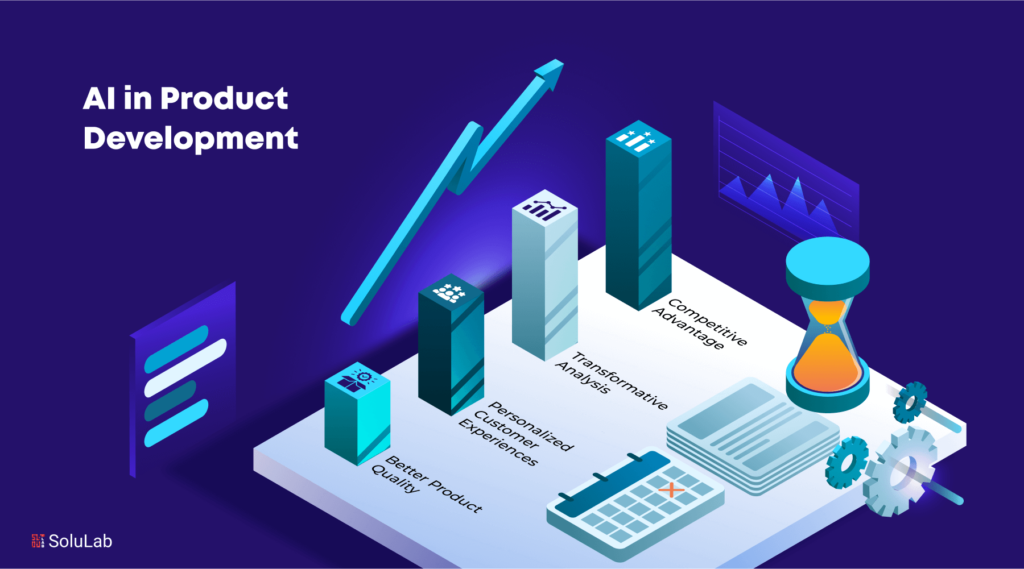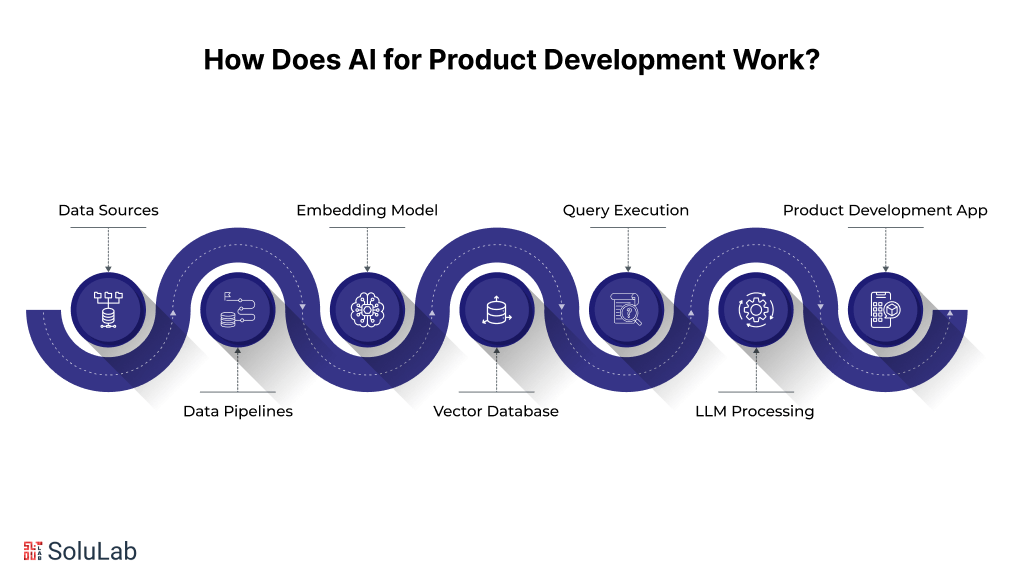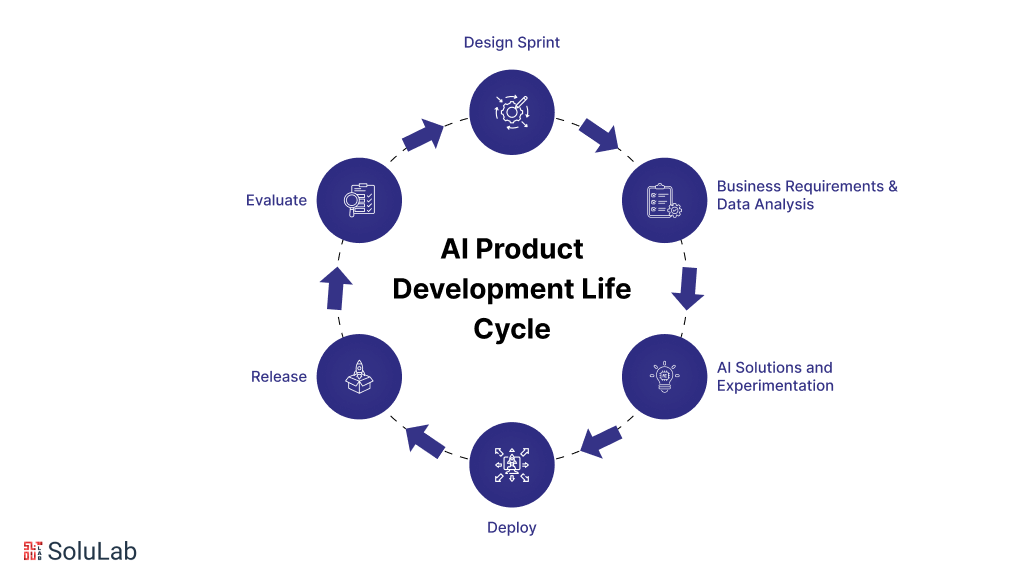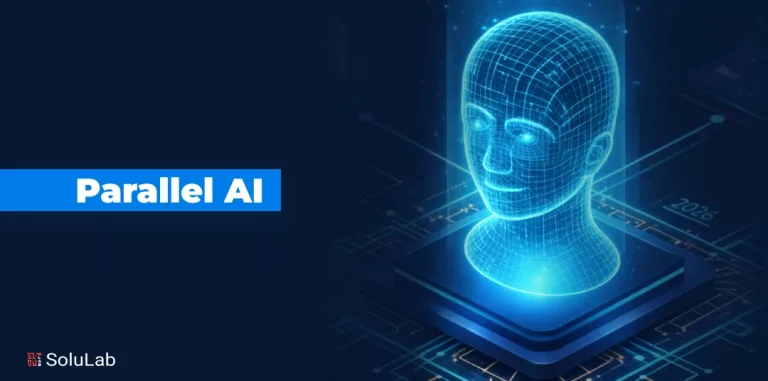
Artificial Intelligence (AI) has become a potent ally in modern product creation, where interdisciplinary collaboration is essential, redefining efficiency, quality, and creativity. From research to refining, artificial intelligence (AI) is a crucial component of every step of the product development process. It serves as a collaborator and an effective task “Automator,” encouraging creativity and innovation along the way. The number of AI tools is expanding quickly and being integrated into corporate processes. PwC reports that businesses that have progressed in applying AI and ML to product development—dubbed Digital Champions—have seen over 30% of their income come from totally digital goods or services, setting a standard for technology adoption. Additionally, Digital Champions employs AI and ML to boost productivity and shorten development schedules in areas like product lifecycle management and digital prototyping.
When developing a product, the goal is to have users actively engage with it. According to Userpilot, only 17% of users utilize the SaaS products they are given. If fewer people engage with your product, they may miss the value it offers and are less likely to renew their subscription.
Thus, building an exceptional product and ensuring market fit is vital in any product experimentation process. However, understanding potential users, gathering deeper insights from customer data, and constructing prototypes all demand more time than the market often allows.
Products sometimes launch with insufficient brainstorming or hit the market too late. According to a report by Undo, debugging software failures incurs an annual cost of approximately $61 billion, which points to inadequate testing. Yet, with the ongoing advancements in AI product development and the increasing influence of AI in product design, this process is becoming more data-driven and streamlined.
In this blog, we will explore how artificial intelligence (AI) is changing the product development process. We will also emphasize the technology’s powerful impact, its strategic advantages, and the countless opportunities it creates for creative, efficient, and futuristic product development paths.
What is AI in Product Development?
AI has become a vital tool for contemporary product development and transforming how businesses envision, create, and launch goods. AI is essential for streamlining production procedures and guaranteeing quality control during the manufacturing stage. By using AI to evaluate sensor data from equipment and anticipate possible breakdowns before they happen, predictive maintenance algorithms lower maintenance expenses and downtime. AI-driven quality control services improve overall product quality by quick and accurate inspection of products.
Recommendation engines driven by AI examine user preferences and behavior to provide customized product recommendations that increase client loyalty and satisfaction. Additionally, AI-driven analytics enables businesses to get real-time customer input, identify areas that require improvement, and make necessary changes to product features and functions.
How does AI for Product Development Work?

The AI product design generator changes traditional practices by using highly developed LLMs and immeasurable amounts of product data and market data. This novel way of properly framing decisions and data enhances decision-making and data usage to a more knowledgeable product formation process. This architecture employs several unique parts to facilitate the creation of products with AI technology. This is a detailed explanation of how it operates:
1. Data Sources
AI in Product Development relies on broad data sources to inform its strategy, including:
- Buyer data in terms of current and past values of consumer preferences, trends in the market that require product positioning and designs, and competition analysis.
- Systematic comprehension of the user needs and problem concerns arising from their use pattern and feedback, and customer assessment.
- Product-related information from the past regarding currently existing products, their lifecycles, user interaction, and effectiveness metrics.
2. Data Pipelines
MLOps Pipelines make use of data pipelines employed for moving data from the sources enumerated above. Out through these pipelines, data is arranged and cleaned in a manner that can be subjected to further processes.
3. Embedding Model
In this analysis, an embedding model is applied to the ready data from the data preparation step. This model translates written text information into vectors that are understandable by the AI product design model and are numerical. Some of the models are Google, Cohere, Open AI, and many more are used in the current world.
4. Vector Database
The produced vectors are stored in what is called a vector database to allow for proper searching and recovery. Some of the vector databases include Pinecone, Weaviate, and PGvector.
5. Query Execution
When a user types a search request in the product development app, data acquisition and search are initiated. Such inquiry can refer to any question related to the development strategy, the fit with a particular market, or a product offering.
6. LLM Processing
It also forwards the question to the orchestration layer once it has been received. This layer passes appropriate data to the concerned LLM for further processing once the data is obtained from the vector database as well as the LLM cache. Depending on the type of query required, a particular Logical Level Model (LLM) is used.
Related: Comparison of Large Language Models
7. Product Development App
What the teams receive is the ability to quickly access certain information required for product development through an app built for this purpose, which then provides the user with AI suggestions.
It is a detailed approach that gives a clear and straightforward description of how exactly product development is accelerated by the application of AI and the folding of different sorts of data and tools. AI in product design can help to optimize many tasks connected with product creation, increase business productivity, and provide a better examination of the market and product data.
How Does AI in Product Development Transform the Process?
AI for product development organizations with an interest in technology and believe that artificial intelligence (AI) for engineering, design, and research could be a great improvement. However, it is still in its infancy. Uncertainties concerning products created with the help of AI, and the shortcomings of AI at the moment are not protected by sufficient measures.
Although there is still much we don’t know about the quickly developing field of artificial intelligence, we can already see potential advantages in the following applications as we investigate how the available AI tools such as customer service automation might best complement and improve our design procedures and methods:
- Introducing the Bases: They turn to artificial intelligence solutions that provide boilerplate language, and basic concept concepts to make the work go faster.
- Enhancing Human Perception: AI in project management entails the capacity to analyze requirements and data with a view of making recommendations as well as supporting and in some cases assisting in decision-making. It is necessary to measure the results, however, against some conceptual or practical benchmark of some kind.
- Check Gut: AI is useful in identifying potential issues with a product and suggesting that areas of the product be modified because they are problematic before the end product is out on the market.
Read Also: How to Create an AI-Powered App like Doppl?
Stages of Integrating AI in Product Development

Integrating AI use cases into your product development cycle adds competitiveness as well as productivity and creativity to the entire business. Such conditions may indicate a well-suited make for a product of perfect market conformity, originality, and market-ready quality, if a highly trained group is assembled, intensive market research is being conducted, and AI is integrated into the project systematically. This is a detailed explanation of how to infuse AI into your product design cycle.
1. Market research
Before beginning an AI product visualization process with incorporates artificial intelligence it is pertinent to understand the market conditions. Begin the process with a market research technique that is an emulator to the next step in discovering a unique product concept that fulfills the perceived needs of the market and is a surprise to competitors.
2. Building the Best Team
An insightful team is required to overcome the potential pitfalls of bringing in AI and integrating it into the systems. Check out your available resources to determine whether your team has the right skills to apply the advanced AI procedures out there. In cases where there is little or no experience in something consider outsourcing the same. Slowing the development process down to teams with outside software development firms or independent contractors to increase the quality of your employees can be a good idea. However, whenever you are choosing your outside partners make sure that they are experienced and that they are willing to see your project thrive.
3. Outsourcing
Outsourcing, hence, comes with many choices, of which the following are viable. Freelancers do offer flexibility in the sense that one can handle many things but managing many things can be a weakness when fulfilling a project. Specialized software development firms, on the other hand, have a rich supply of personnel, prescreened and properly selected. These businesses commonly employ experienced Project Managers who can plan out the development stage and guarantee that the AI is incorporated into your product in a way that aligns best with your product planning.
4. AI Integration in the Development Phase
Implementation of AI in Design and Product Development should be a deliberate decision regarding which phases of product development to incorporate AI in deliberately, rather than just chaotically involving AI throughout the process randomly If the info and your understanding of your business area allow for it, strategically decide on which design and testing phases, marketing avenues, etc. would be most beneficial to have AI in deliberately. Ensure that the AI technologies are properly aligned in a manner to enhance the product’s promising prospects by optimally integrating corresponding processes into the product and enhancing its overall sustainability and market appeal.

AI in product development: Key use cases
Here are the major use cases of AI in product development:
1. Producing
AI is used in enhancing the manufacturing processes of assembly lines. These work because the AI trism technology learns and examines dynamics and employs its deep data analytics to quickly diagnose and fix issues within the operation line. It has been accustomed that integrating AI into industries decreases operational costs whilst enhancing the industrial results through enhanced system organization, scheduling, and output. Through such integration of artificial intelligence, processes are made efficient, productivity is enhanced and industrial operations are made to maintain or achieve the competitive edge required in volatile markets.
Read Also: How to Develop an AI SaaS Product?
2. Creating Graphics
AI assists designers in delivering many different suggestions as to design options based on user data, which is useful for the further cultivation of user aesthetics, UI, and UX. There are various applications of AI in software development and UI design is one such area where AI-driven design tools assist the developers in designing better interfaces by making usage data-driven suggestions concerning trends as well as user preferences.
3. Methodology of Product Development
AI helps firms to get valuable insights about the future directions of product development which in turn helps the firms to make better strategic decisions. Many dimensions that can be analyzed through AI algorithms include market trend patterns, customers, and competitor data, which can be used to discover opportunities, refine product attributes, and align strategic plans with the market environment. This ensured the firms kept high rates of success for new product development hence carrying out the objective of countering market failure effectively.
4. Product Design
From that perspective, AI in business transforms the way of designing products by analyzing a wide variety of design options and allowing the development of unique and well-designed items. Furthermore, AI also analyzes user preferences and feedback, which helps the company make better adjustments in their designs according to the customer’s needs and improves the user experience.
Benefits of AI in Product Development
The following are the major benefits of AI in product development giving you an insight into why you need it:
-
Better Product Quality
AI-generated products can perform complex simulations, tests, and validations of new products has a positive impact on their quality when implemented with artificial intelligence systems. Such systems may effectively mimic several situations before developing real models, determine the flaws in the design, and improve the performance of products. It also ensures Quality Assurance which makes it possible to meet or even exceed the client’s expectations because of reducing the time and cost of continuing to create several versions.
-
Personalized Customer Experiences
Personalization of products and targeting is critical during this period, and this requires artificial intelligence. Such approximately honest artificial intelligence (AI) algorithms as consumer profiling, recommender systems, and the associated menu of product features based on user data, and advisable items. Such customized experiences enhance repetitive business, brand preferences, or loyalty, as well as customer satisfaction.
-
Transformative Psychometric Analysis
Based on psychometric analysis user preferences and behavior high-frequency information can be delivered to the developers by using artificial intelligence (AI). AI also assists in understanding the target audience’s needs based on analyzing complicated user behavior patterns making developers work on more effective and engaging products. But this methodology just drives success in the market by increasing customer delight and building improved associations between customers and commodities.
-
Competitive Advantage
If businesses adopt generative AI product prototypes in product creation, they get a massive competitive edge, and this, in my view, is crucial. Machine learning-driven analysis provides a quick ability to react to numerous fluctuations in the market, thus making the business a pioneer in terms of adaptability. This flexibility leads to punctual getting-through of products that deliver more value than competitors to consumers. In addition, the work is eased by AI, enhancing efficiency, and reducing cycle time to market while providing the organization with value.
Challenges and Considerations in AI Integration
Mixed up in all these features of AI is the issue of defining what AI is not and what is it unable to do as a way of optimizing for the benefits of AI while at the same time not being on the wrong side of the equation. So, I think it is essential to understand the pros and cons of this new generation of AI solutions but, perhaps it is even more important to consider how to use AI wisely and helpful to our clients.
- AI is Unaware of Context: Designing at its basic level therefore hinges on understanding the specific environment where solutions are expected to be used. However, there’s one inconvenience; AI outputs can neither understand important aspects that may be providing the problems nor recognize them. While the other kind of it might give advice or concepts, which involve very few or no aspects of the topic at all.
- AI is Not Omnipotent or Omniscient: AI firms oftentimes make their products sound like they are almost magical, little do customers know that the effectiveness of the tools used depends on the quality of data used in developing the systems. These hidden AI manufacturing techniques becoming visible will help users overcome over-reliance by exposing them to how AI results are obtained. The input data that AI uses during its training can include English language data which by its nature involves related culture and demographic prejudice and thinking which can also be prejudiced.
- AI is Not Easy or Straightforward: You may have probably already noticed that when communicating with AI use imperative skills if you have tried generative AI like ChatGPT or MidJourney. As it will be illustrated when discussing the application of AI competency practice, practice is the key to honing any competency including the AI communication skill.
- AI Efficiency Cannot Generate Results: Good design is not overnight work, as it is more than just creating something that aesthetically looks pleasing. Although AI may be able to speed up some phases of the design process for designers and product developers, ultimately they must decide which concepts are to be pursued and then developed and adapted appropriately to suit the needs of people and project requirements. Great design must also involve testing and iteration procedures, which are time-consuming.
Future Trends of AI in Product Development
AI is armed with a huge potential that changes product development at a very high speed and as technology forges ahead, new trends continue to emerge. Listed below are a few of the most auspicious upcoming developments in AI product development:
With the help of AI development companies, businesses can better create products and services that are adapted to every individual. For instance, AI enables predicting the best options of colors, sizes, and features of the products based on the data on the customer’s previous purchases, searched products, and other options chosen by him. Through applying AI in product development, companies are able, for example, to predict how many customers would need a specific product, and therefore manage their stock better. It must be noted that through the efficient application of artificial intelligence, businesses can leverage augmented reality (AR) technology for product experience.
AI can provide timely feedback on the designs with designers, engineers, or any other stakeholder and fosters product development collaboration. This could help business organizations to deliver high-quality goods in the shortest possible time. Self-constructed commodities are also some other ways through which artificial business can be used to build goods without people’s involvement. This may involve designing models, developing new product ideas, and or, manufacturing of goods with the help of artificial intelligence.
FAQs
1. What is AI in product and development?
AI makes it faster for designers with the help of LLMops to provide a variety of design possibilities depending on the user input which not only helps with UI/UX designs but also with the designing of user aesthetics.
2. What are the examples of generative AI in product development?
Reinforcement learning has been applied in generative AI to create pharmaceuticals, music, and semiconductors these are some examples of gen AI in product development. It has also reduced the time required for planning and designing products.
3. What purpose do fairness measures in AI product development?
Fairness measures are used in the development of AI products to guarantee that different user groups receive the same treatment. The goal of create techniques and systems that can reduce prejudices and stop discriminatory treatment for various groups.
4. What is the main role of AI in product design?
Wearables, tablets, smartphones, and other electronic product designs are made with artificial intelligence. It can be used to find design defects, enhance product functionality, and improve user experience with feedback loops.
5. Is SoluLab able to provide AI solutions to businesses?
Yes, SoluLab provides AI solutions to businesses that will reduce the overall risk of regulatory violations and fines by automating compliance checks and keeping up-to-date records of financial transactions and many more services.






